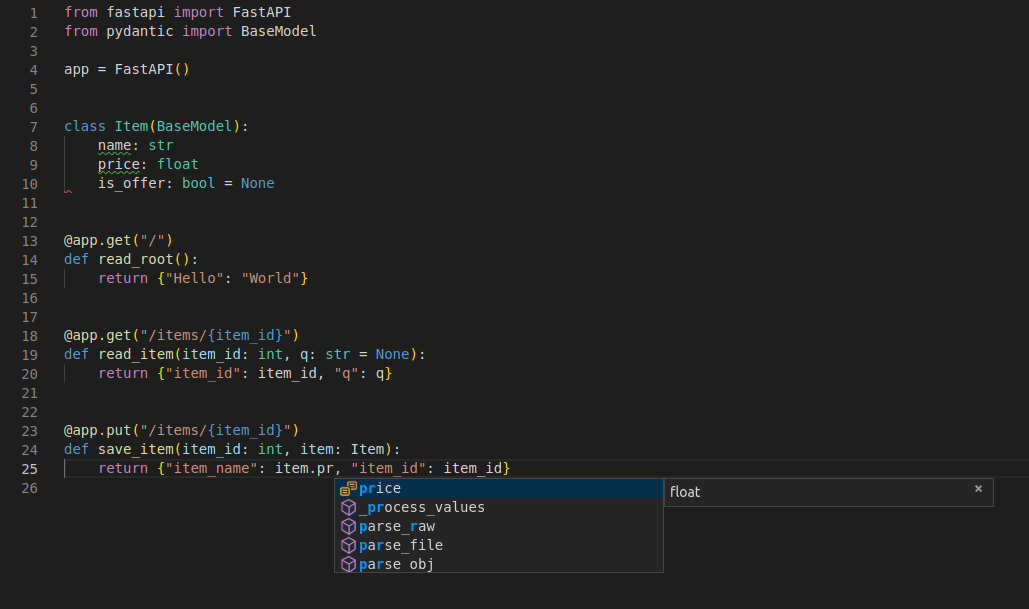- Sort Score
- Result 10 results
- Languages All
Results 1 - 10 of 30 for baek (0.15 sec)
-
docs_src/sql_databases/sql_app_py39/models.py
Python - Registered: Sun Apr 28 07:19:10 GMT 2024 - Last Modified: Tue Jan 09 14:35:33 GMT 2024 - 710 bytes - Viewed (0) -
docs/en/docs/tutorial/index.md
Each section gradually builds on the previous ones, but it's structured to separate topics, so that you can go directly to any specific one to solve your specific API needs. It is also built to work as a future reference. So you can come back and see exactly what you need. ## Run the code All the code blocks can be copied and used directly (they are actually tested Python files).
Plain Text - Registered: Sun Apr 28 07:19:10 GMT 2024 - Last Modified: Sat Jun 24 14:47:15 GMT 2023 - 2.5K bytes - Viewed (0) -
docs/en/docs/how-to/custom-docs-ui-assets.md
``` !!! tip The *path operation* for `swagger_ui_redirect` is a helper for when you use OAuth2. If you integrate your API with an OAuth2 provider, you will be able to authenticate and come back to the API docs with the acquired credentials. And interact with it using the real OAuth2 authentication. Swagger UI will handle it behind the scenes for you, but it needs this "redirect" helper.Plain Text - Registered: Sun Apr 28 07:19:10 GMT 2024 - Last Modified: Mon Oct 30 09:58:58 GMT 2023 - 7.5K bytes - Viewed (0) -
docs/tr/docs/features.md
Bütün **FastAPI** frameworkü oto-tamamlama açısından geliştiriciyi tatmin etmek üzerine tasarlandı. Otomatik tamamlama her yerde çalışıyor. Dokümantasyona tekrardan çok nadir olarak geleceksin. Editörün sana nasıl yardım ettiğine bir bak: * <a href="https://code.visualstudio.com/" class="external-link" target="_blank">Visual Studio Code</a> ile: 
Plain Text - Registered: Sun Apr 28 07:19:10 GMT 2024 - Last Modified: Thu Apr 18 19:53:19 GMT 2024 - 11.1K bytes - Viewed (0) -
docs/en/docs/index.md
* `UUID` objects. * Database models. * ...and many more. * Automatic interactive API documentation, including 2 alternative user interfaces: * Swagger UI. * ReDoc. --- Coming back to the previous code example, **FastAPI** will: * Validate that there is an `item_id` in the path for `GET` and `PUT` requests. * Validate that the `item_id` is of type `int` for `GET` and `PUT` requests.Plain Text - Registered: Sun Apr 28 07:19:10 GMT 2024 - Last Modified: Thu Apr 18 23:58:47 GMT 2024 - 19.2K bytes - Viewed (0) -
docs/en/docs/tutorial/sql-databases.md
!!! warning This example is not secure, the password is not hashed. In a real life application you would need to hash the password and never save them in plaintext. For more details, go back to the Security section in the tutorial. Here we are focusing only on the tools and mechanics of databases. !!! tipPlain Text - Registered: Sun Apr 28 07:19:10 GMT 2024 - Last Modified: Thu Apr 18 19:53:19 GMT 2024 - 29.6K bytes - Viewed (0) -
docs/en/docs/async.md
For a more "real life" example of this, imagine a bank. Up to recently, most of the banks had multiple cashiers 👨💼👨💼👨💼👨💼 and a big line 🕙🕙🕙🕙🕙🕙🕙🕙. All of the cashiers doing all the work with one client after the other 👨💼⏯. And you have to wait 🕙 in the line for a long time or you lose your turn. You probably wouldn't want to take your crush 😍 with you to do errands at the bank 🏦. ### Burger Conclusion
Plain Text - Registered: Sun Apr 28 07:19:10 GMT 2024 - Last Modified: Thu Apr 18 19:53:19 GMT 2024 - 23K bytes - Viewed (0) -
docs_src/sql_databases/sql_app/models.py
Python - Registered: Sun Apr 28 07:19:10 GMT 2024 - Last Modified: Tue Jan 09 14:35:33 GMT 2024 - 710 bytes - Viewed (0) -
tests/test_sub_callbacks.py
invoice. And this path operation will: * Send the invoice to the client. * Collect the money from the client. * Send a notification back to the API user (the external developer), as a callback. * At this point is that the API will somehow send a POST request to the external API with the notification of the invoice eventPython - Registered: Sun Apr 28 07:19:10 GMT 2024 - Last Modified: Fri Jul 07 17:12:13 GMT 2023 - 13.8K bytes - Viewed (0) -
docs/en/docs/tutorial/security/simple-oauth2.md
Whenever you pass exactly the same content (exactly the same password) you get exactly the same gibberish. But you cannot convert from the gibberish back to the password. ##### Why use password hashing If your database is stolen, the thief won't have your users' plaintext passwords, only the hashes.
Plain Text - Registered: Sun Apr 28 07:19:10 GMT 2024 - Last Modified: Thu Apr 18 19:53:19 GMT 2024 - 12.5K bytes - Viewed (0)